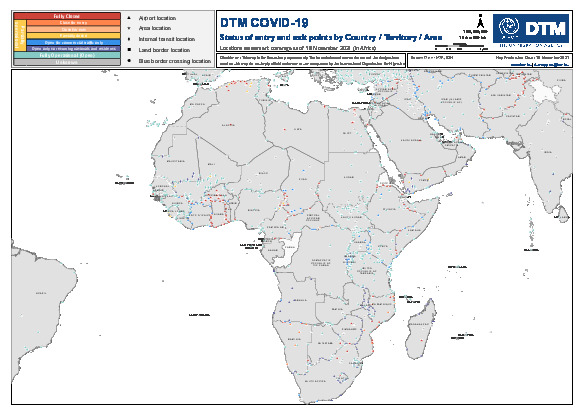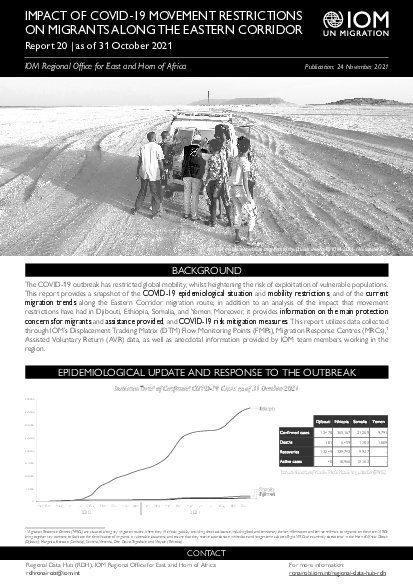-
Countries
-
Data and Analysis
-
Special Focus
-
Crisis Responses
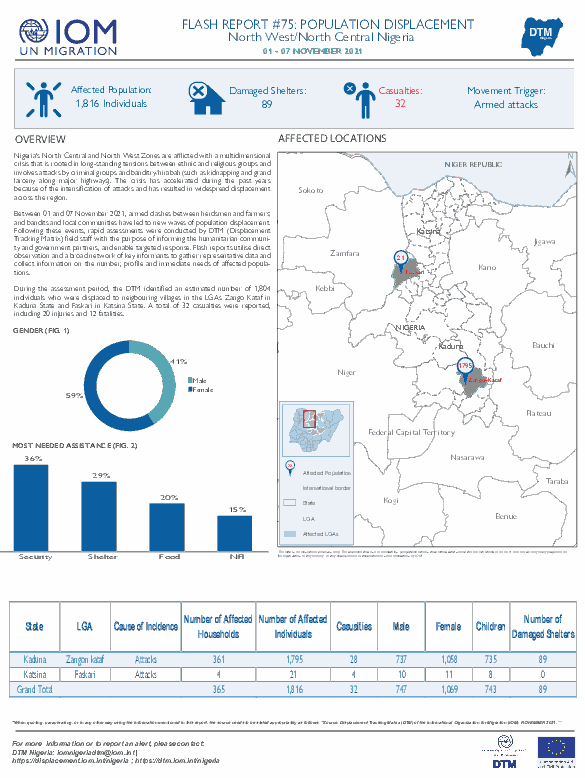
Contact
DTM Nigeria, AllUsersInDTMNigeria@iom.int
Language
English
Location
Nigeria
Period Covered
Nov 01 2021
Nov 07 2021
Activity
- Event Tracking
- Mobility Tracking
Nigeria's North Central and North West Zones are afflicted with a multidimensional crisis that is rooted in long-standing tensions between ethnic and religious groups and involves attacks by criminal groups and banditry/hirabah (such as kidnapping and grand
larceny along major highways). The crisis has accelerated during the past years because of the intensification of attacks and has resulted in widespread displacement across the region.
Between 01 and 07 November 2021, armed clashes between herdsmen and farmers; and bandits and local communities have led to new waves of population displacement. Following these events, rapid assessments were conducted by DTM (Displacement
Tracking Matrix) field staff with the purpose of informing the humanitarian community and government partners, and enable targeted response. Flash reports utilise direct observation and a broad network of key informants to gather representative data and collect information on the number, profile and immediate needs of affected populations. During the assessment period, the DTM identified an estimated number of 1,804 individuals who were displaced to neigbouring villages in the LGAs Zango Kataf in
Kaduna State and Faskari in Katsina State. A total of 32 casualties were reported, including 20 injuries and 12 fatalities.

Contact
DTM Nigeria, AllUsersInDTMNigeria@iom.int
Language
English
Location
Nigeria
Period Covered
Oct 25 2021
Oct 31 2021
Activity
- Event Tracking
- Mobility Tracking
Nigeria's North Central and North West Zones are afflicted with a multidimensional crisis that is rooted in long-standing tensions between ethnic and religious groups and involves attacks by criminal groups and banditry/hirabah (such as kidnapping and grand larceny along major highways). The crisis has accelerated during the past years because of the intensification of attacks and has resulted in widespread displacement across the region. Between 25 and 31 October 2021, armed clashes between herdsmen and farmers; and bandits and local communities have led to new waves of population displacement. Following these events, rapid assessments were conducted by DTM (Displacement Tracking Matrix) field staff with the purpose of informing the humanitarian community and government partners, and enable targeted response. Flash reports utilise direct observation and a broad network of key informants to gather representative data and collect information on the number, profile and immediate needs of affected populations. During the assessment period, the DTM identified an estimated number of 531 individuals who were displaced to neigbouring villages in the LGAs Zurmi in Zamfara State and Sabuwa in Katsina.
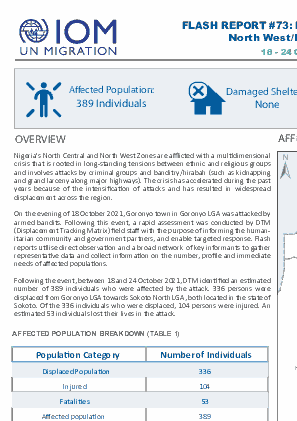
Contact
DTM Nigeria, AllUsersInDTMNigeria@iom.int
Language
English
Location
Nigeria
Period Covered
Oct 18 2021
Oct 24 2021
Activity
- Event Tracking
- Mobility Tracking
Nigeria's North Central and North West Zones are afflicted with a multidimensional crisis that is rooted in long-standing tensions between ethnic and religious groups and involves attacks by criminal groups and banditry/hirabah (such as kidnapping and grand larceny along major highways). The crisis has accelerated during the past years because of the intensification of a?acks and has resulted in widespread displacement across the region. On the evening of 18 October 2021, Goronyo town in Goronyo LGA was attacked by armed bandits. Following this event, a rapid assessment was conducted by DTM (Displacement Tracking Matrix) between 18 and 24 October 2021, identifying n estimated number of 389 individuals who were affected by the attack. 336 persons were displaced from Goronyo LGA towards Sokoto North LGA, both located in the state of Sokoto. Of the 336 individuals who were displaced, 104 persons were injured. An estimated 53 individuals lost their lives in the attack.
Flash reports utilise direct observation and a broad network of key informants to gather representative data and collect information on the number, profile and immediate needs of affected populations.
The current outbreak of COVID-19 has affected global mobility in complex and unprecedented ways in the form of various travel restrictions, suspension of air travel, and border closures. To better understand this, the International Organization for Migration (IOM) has developed a global mobility database to map these impacts on human mobility, across global, regional, and country levels. Furthermore, COVID-19 has had a disproportionate impact on vulnerable populations in camps and camp-like settings as well as exacerbated the vulnerabilities of mobile populations who may now be stranded owing to COVID-19 related mobility restrictions. This data is particularly important when addressing specific needs faced by migrants and mobile populations.
IOM has developed a global mobility database mapping the status of different Points of Entry (PoE) and Key Locations of Internal Mobility, globally. These include airports, land border crossing points (could be rail or road), blue border crossing points (sea, river or lake), internal transit points, and areas of interest. For each point of entry, data is collected on the type of restriction, measured applied, and the timeframe, as well as the population category that may be affected by the restrictive measures. This workstream uses direct input from IOM missions and this dashboard displays regularly updated mobility restrictions at the location level.
The COVID-19 outbreak has restricted global mobility, whilst heightening the risk of exploitation of vulnerable populations.
This report provides a snapshot of the COVID-19 epidemiological situation and mobility restrictions, and of the current
migration trends along the Eastern Corridor migration route, in addition to an analysis of the impact that movement
restrictions have had in Djibouti, Ethiopia, Somalia, and Yemen. Moreover, it provides information on the main protection
concerns for migrants and assistance provided, and COVID-19 risk mitigation measures. This report utilizes data collected
through IOM’s Displacement Tracking Matrix (DTM) Flow Monitoring Points (FMPs), Migration Response Centres (MRCs),
Assisted Voluntary Return (AVR) data, as well as anecdotal information provided by IOM team members working in the
region.
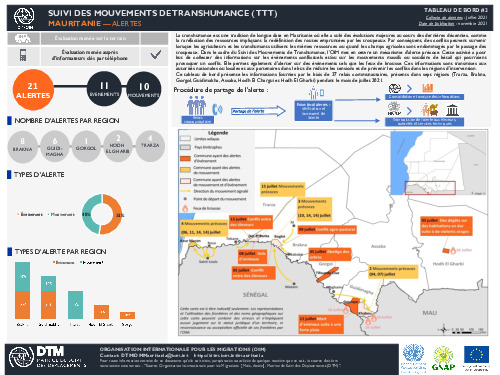
Contact
DTM Mauritania, DTMMauritania@iom.int
Language
French
Location
Mauritania
Period Covered
Jul 01 2021
Jul 30 2021
Activity
- Event Tracking
- Survey
- Flow Monitoring Survey
- Flow Monitoring
La transhumance est une tradition de longue date en Mauritanie où elle a subi des évolutions majeures au cours des dernières décennies, comme la raréfaction des ressources impliquant la redéfinition des routes empruntées par les troupeaux. Par conséquent, des conflits peuvent survenir lorsque les agriculteurs et les transhumants utilisent les mêmes ressources ou quand les champs agricoles sont endommagés par le passage des troupeaux. Dans le cadre du Suivi des Mouvements de Transhumance, l’OIM met en oeuvre un mécanisme d'alerte précoce. Cette activité a pour but de collecter des informations sur les évènements conflictuels et/ou sur les mouvements massifs ou soudains de bétail qui pourraient provoquer un conflit. Elle permet également d'alerter sur des évènements tels que les feux de brousse. Ces informations sont transmises aux autorités nationales ou locales et aux partenaires dans le but de réduire les tensions et de prévenir les conflits dans les régions d’intervention. Ce tableau de bord présente les informations fournies par le biais de 37 relais communautaires, présents dans sept régions (Trarza, Brakna, Gorgol, Guidimakha, Assaba, Hodh El Chargui et Hodh El Gharbi) pendant le mois de juillet 2021.

Contact
DTM Mali, DTMMali@iom.int
Language
French
Location
Mali
Period Covered
Sep 01 2021
Sep 30 2021
Activity
- Mobility Tracking
- Baseline Assessment
Afin de répondre aux besoins des populations déplacées internes, rapatriées et retournées, la Commission Mouvement de Populations (CMP) recueille et analyse les informations sur les mouvements de populations à l’intérieur du Mali, afin de fournir une situation complète des mouvements de populations et à la demande de ses partenaires. A la date du 30 septembre 2021, les partenaires de la CMP ont comptabilisé: 401 736 PDI, 606 617 PDIs retournées et 83 712 rapatriés (anciens réfugiés).
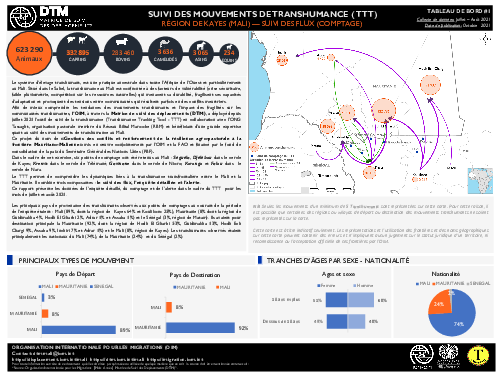
Contact
DTM Mali, DTMMali@iom.int
Language
French
Location
Mali
Period Covered
Jul 01 2021
Aug 31 2021
Activity
- Event Tracking
- Other
- Survey
- Flow Monitoring Survey
- Flow Monitoring
Afin de mieux comprendre les tendances des mouvements transhumants et l’impact des fragilités sur les communautés transhumantes, l’OIM, à travers la Matrice de suivi des déplacements (DTM), a déployé depuis juillet 2021 l’outil de suivi de la transhumance (Transhumance Tracking Tool - TTT). Dans le cadre de cet exercice, six points de comptage ont été retenus au Mali : Séguéla, Djélébou dans le cercle de Kayes; Kremis dans le cercle de Yélémané; Gavinane dans le cercle de Nioro; Korongo et Falou dans le cercle de Nara. Le TTT permet de comprendre les dynamiques liées à la transhumance transfrontalière entre le Mali et la Mauritanie. Il combine trois composantes : le suivi des flux, l’enquête détaillée et l’alerte. Ce rapport présente les données de l’enquête détaillé, du comptage et de l’alerte dans le cadre du TTT pour les mois de juillet et août 2021.
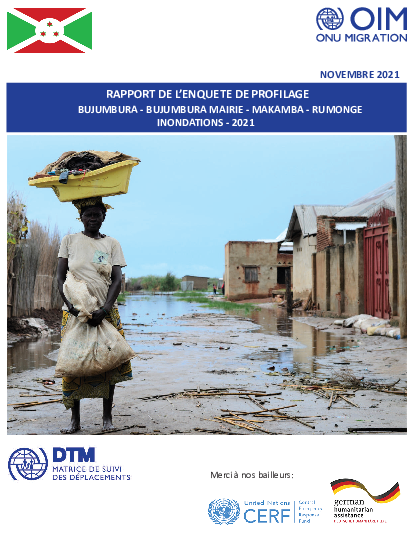
Contact
DTM Burundi, DTMBurundi@iom.int
Language
French
Location
Burundi
Period Covered
Mar 01 2021
May 31 2021
Activity
- Survey
- Return Intention
Entre mars et mai 2021, les provinces de Bujumbura, Bujumbura Mairie, Rumonge et Makamba ont été fortement touchées par des inondations dues à la montée des eaux du Lac Tanganyika qui ont affecté environ 52,000 personnes dont 22 000 déplacées. Dans la province de Bujumbura, certaines personnes déplacées ont été installées dans les sites de Sobel et Kinyinya II qui hébergeaient déjà des personnes déplacées par les inondations de 2020. Dans les autres provinces de Bujumbura Mairie, Rumonge et Makamba, les personnes déplacées étaient logées dans les communautés d’accueil. Dans le cadre de l’enquête de profilage, tous les nouveaux ménages déplacés vivant dans les sites de Sobel et Kinyinya II, et ceux résidant dans les provinces de Bujumbura Mairie, Rumonge et Makamba ont été profilés. Un total de 3 988 ménages déplacés (20 106 personnes) ont été enquêtés.
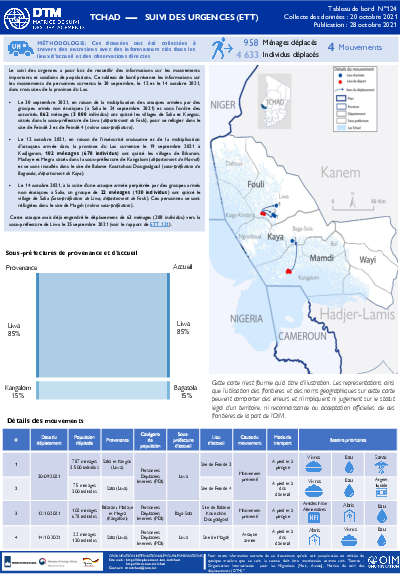
Contact
DTM Tchad, dtmtchad@iom.int
Language
French
Location
Chad
Snapshot Date
Nov 20 2021
Activity
- Event Tracking
- Mobility Tracking
Le suivi des urgences a pour but de recueillir des informations sur les mouvements importants et soudains de populations. Ce tableau de bord présente les informations sur les mouvements de personnes survenus le 30 septembre, le 12 et le 14 octobre 2021, dans trois sites de la province du Lac.
